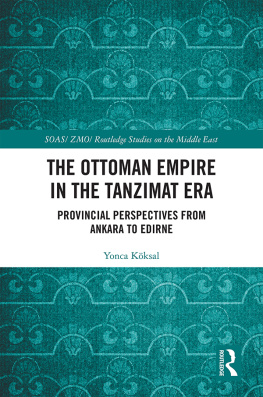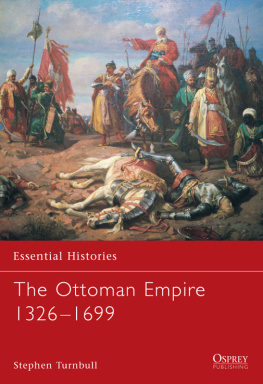The Regency of Tunis, 15351666
The Regency of Tunis, 15351666
GENESIS OF AN OTTOMAN PROVINCE IN THE MAGHREB
LELA BLILI
Translated by Margaux Fitoussi and Anna Boots
The American University in Cairo Press
Cairo New York
This electronic edition published in 2021 by
The American University in Cairo Press
113 Sharia Kasr el Aini, Cairo, Egypt
One Rockefeller Plaza, 10th Floor, New York, NY 10020
www.aucpress.com
First published in French in 2012 by Editions SCRIPT as Sous le toit de l'Empire: La Rgence de Tunis, 1535-1666: Gense dune province ottomane au Maghreb, tome 1Copyright 2012 by Editions SCRIPT
English translation copyright 2021 by Lela Temime Blili
All rights reserved. No part of this publication may be reproduced, stored in a retrieval system, or transmitted in any form or by any means, electronic, mechanical, photocopying, recording, or otherwise, without the prior written permission of the publisher.
ISBN 978 977 416 989 2
eISBN XX
Version 1
I thank Mr. Hazem Ben-Gacem and the team
for the translation of this book.
Contents
Figures
Introduction
T his book is a study of the emergence of modern Tunis starting in the sixteenth century, conducted through a reexamination of the Ottoman occupation of the ancient Hafsid Ifriqiya. I trace the long process of the establishment of the Regency of Tunis, both its territory, through the gradual solidification of what had been loosely defined borders, and its society. The territorial and social identities of this new province were marked by many distinctive characteristics in terms of its relationship with Istanbul: the new borders of the regency were drawn as an imperial province, and individuals originating from throughout the vast territory of the Ottoman Empire settled in Tunis and succeeded in creating a new elite. These people could be categorized into two groups: Muslim Turks coming from the vast Anatolian plateaus, and those who had been captured by piratesChristians by birth who had converted to Islam and thus were also considered Turks. Belonging to this latter group was Mourad Coursou, founder of the Mouradite house and a product of the underworld of captivity.
Under the Ottoman Empire, Tunis became a meeting place for these people with unique pasts, who, in spite of their varied geographic and religious backgrounds, were able to form kinship ties through intermarriage and to improve their standing through alliances with powerful local families. These new arrivals secured wealth and seized political power; thus, poor soldiers from the Anatolian plateaus as well as Mediterranean renegades were able, in a very short time, to form the new nobility of the Regency of Tunis. It is this complex processthe interaction of the social with the political and the religiouswhich we try to follow here.
The precise contours of the Regency of Tunis were produced by a rapidly changing situation, one marked by a series of fits and starts, that must be reconstructed, even if this requires going back in time and rethinking traditional periodizations in order to better understand the sixteenth century, with its crises and its upheavals, as a fundamental moment of transition. For a sixty-year period, from 1530 to 1595, it is difficult to delineate the exact borders of the Hafsid territory of Ifriqiya. The period of July and August of 1574 seems to have represented a major shift, with the capture of Tunis and La Goulette, the departure of the Spanish and the last Hafsid rulers, and the installation of the Ottoman Turks. This important military victory did not mean that the Ottomans controlled the territory completely; rather, it initiated a difficult period during which the new authority strove to establish itself.
Historians have traditionally divided Ottoman history into three chronological phases beginning with 1574: the period of the pashas (157491); the period of the deys (15911631); and the period of the Mouradite beys (16311702). This chronology highlights the weakening authority of the pashas and the Turkish deys, in favor of the Mouradite beys. Such a convulsive succession of rulers suggests an effort to establish indigenous identity in opposition to the foreign Turks. This work proposes an alternative chronology, one that begins in 1535 and ends with the death of Hamouda Pasha Bey in 1666. It returns to the founding of Algiers by Barbarossa and its consolidation by Khayriddine as part of the project to create a Maghrebi state under Ottoman control, in which the Andalusian population would form the linchpin. The military victory of 1574 would in this context have been one step toward the ultimate aim of the great corsairs, which their successors continued to pursue until 1587. But this plan failed. Instead, three oujaks, or provinces, were established in the Maghreb: Algiers, Tripoli, and Tunis. They were autonomous from one another but shared a common fate, and people circulated among them with incredible frequency. After being caught in the pincers of both the Turks and the Spanish, the territory of Hafsid Ifriqiya shrank considerably. Tunis fell sometimes under the rule of Algiers and sometimes of Tripoli. When the sultan caliph decided to bring an end to the unity of the three oujaks of the Maghreb, each of the three embarked on its own political and social path. Borders that had been fluid and ambiguous began to solidify. The ruling powers that established themselves in the three cities were distinct from one another, and their destinies depended, in part, on the men who governed them. The features of each province began to take form, accentuated by geographical conditions that promoted increasing centralization in the Regency of Tunis.
A Difficult Reconstruction of Historical Events
Reconstructing events, establishing a chronology, and identifying individual men and women are necessary steps toward renewing and refining readings of macrohistory. This is an essential but difficult process, because the sources do not always answer the questions being posed. There is also the problem of local sources from this long, blurry era, during which the end of Hafsid rule, Spanish occupations, tribal insubordination, the rise of Marabout powers, and Ottoman interventions all coincided. Tunisian chronicles, which were often written much later than the events they describe and which build off one another, constitute the bulk of local sources in the absence of official documents dating back to this period. Nevertheless, it is possible to gain new insights from these sources if we rethink the way that we use them. There is also a formidable collection of narratives from European travelers, diplomats, and former captives, which historians have used with eagerness, given the gaping void in local sources. And yet, despite the detailed work done by these authors, their stories impose a version of the facts heavily shaped by their authors biases. I am not suggesting that these sources lack objectivity, but merely underlining that, in common with all writers, the authors of these narratives describe local political institutions and their mode of operation through an individual lens. I will bring a different reading to official Spanish, Italian, and French sources that have previously been published in historical reviews, and I will make use of important Turkish documents that have been translated into Arabic. This deliberately descriptive approach will allow for a precise reconstruction of historical events, in order to better recreate several episodes, with a focus on the long demise of the Hafsids (153574) and the so-called period of the pashas (157491). We discover that the three ruling powersthe pashas, the deys, and the beyswere overlapping, not successive dynasties, and that the beys and the deys were linked by strong family ties. If these family relationships have escaped attention until now, it is because scholarship wasnt concerned with the roles of women. The reconstruction of marriages and matrimonial alliances will allow us to identify the housesthe









